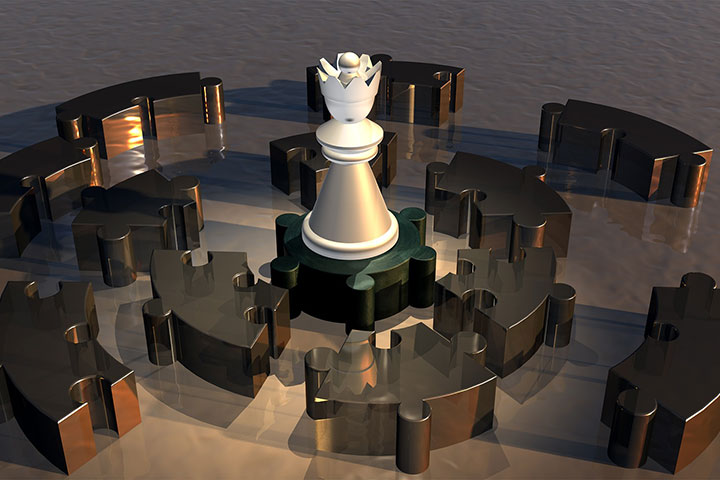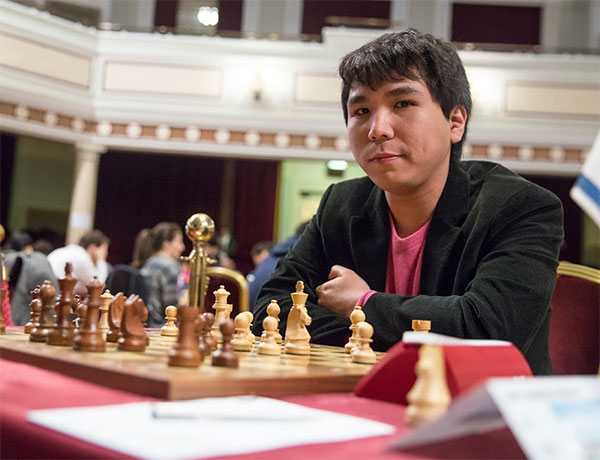


 Wesley So's calm and easy looks during a game concealed the tremendous concentration and intensity happening in the background. I was able to watch some of his games at the Isle of Man tournament in 2016 and have attempted to put myself in his shoes and tease out the reasoning behind his thought process and moves based on his game against Julio Granda Zuniga. This game made a deep impression on me, even during the tournament itself. Of course, I have to make certain guesses and the annotations themselves can never be equal to a player expressing his own thoughts. Nevertheless, it was quite an experience for me to put myself in his thinking hat and in the process trying to unravel the beauty hidden behind the veil of seemingly unnatural moves.
Wesley So's calm and easy looks during a game concealed the tremendous concentration and intensity happening in the background. I was able to watch some of his games at the Isle of Man tournament in 2016 and have attempted to put myself in his shoes and tease out the reasoning behind his thought process and moves based on his game against Julio Granda Zuniga. This game made a deep impression on me, even during the tournament itself. Of course, I have to make certain guesses and the annotations themselves can never be equal to a player expressing his own thoughts. Nevertheless, it was quite an experience for me to put myself in his thinking hat and in the process trying to unravel the beauty hidden behind the veil of seemingly unnatural moves.

What should Black play? Try to think on your own and then test your idea against Fritz before looking at the solution below.
Buttons (from left to right): New game (from the given position), Take back move, Play move forwards, Play now, Get hint, Very weak opponent (baby mode), Serious amateur (blue tie), Club player (blue T-shirt), Master (Yay!), Switch colours, analyse with a chess engine. You can even change sides by taking back an opponent's move and playing a different one yourself.

Wesley So at the Isle of Man International 2016 | Photo: Alina l'Ami
Vidit showed this position over dinner and asked me to guess what Black had to do. Even, after having been given this position I could not find a way as to how Black should go about saving the pawn after a few minutes thought. I remember that my thoughts only centred around a move like c7-c5.
14....g5!!
This move was outside my horizon of available candidate moves as it weakened Black's kingside pawn cover and is not very common in this kind of semi-open English Opening positions. It is quite common for the chess player's brain to filter out such seemingly anti-positional moves, but the beauty of chess as an art lies in discovering such exceptions to the classical principles.
Once I came to know that g5 had been played, I was impressed by it and tried to discover the genesis of the idea. In Chennai chess circles I came across the term "Kokki Ghoda" (part Hindi and part Tamil roughly translating to "Hooked Horses"!) while I was frequenting chess clubs and local events 25 years ago. What it meant was that two knights mutually supporting each other are not as strong as they seem to be, because if any one of them is attacked by a pawn, the other knight loses its support. Using that idea, Black has found a very clever way to break the "hook" by preparing to attack both the knights on b3 and on f3 with pawns on a5 and g5!
Black had to visualize this already while playing 12...a5, especially the g5 idea. This deep idea might have been missed by Granda, who in his own right is also a very original thinker!

Once again, what should Black do? Take your time, put yourself in Wesley's shoes and come up with an original move
16...Re5!!
A stunning move and perhaps the most difficult one of the game. It protects the a5 pawn, restricts the knight on b3 by controlling c5 square and stops any possible checks on g5. It also restricts the knight on h4 by controlling f5 square. Apart from all this, Black's rook freely wanders the open 4th rank! This is quite an uncommon idea and is aesthetically pleasing to see the rook being employed horizontally.
What a position! Black's bishops perform excellent functions while still situated on their original squares. His only developed piece on b2 is wreaking havoc over White's helpless pawns. Once Black wins the pawn on a2 the rook on a8 finds employment right at home!
On the contrary White's knight on h4 is out of play. The seemingly active fianchettoed bishop can perhaps help White to gain a meagre pawn on b7, but White would lose the all-important a2-pawn after which Black's passed a-pawn would become a monster.
Play continued 18...Rb5 19.Rxc7 Qxf4 20.exf4 a4 21.Nxd4 Rxb2:
From a search on MegaDatabase 2018, you realize that the move 14...g5 was played between Markov and Frolyanov a year before Wesley had tried it. We asked So (via email) whether he had seen the move, to which he replied that he had seen a similar motif in his preparation but not the exact move in the exact position.
This once again brings us to an important point that strong players know their patterns very well. And this helps them to execute moves like ...g5 and ...Re5 with ease. Let's have a look at some games which have similar themes to what Wesley So used against Granda Zuniga.
While studying this game, I was reminded of two other games by great champions: one by Karpov and the other by Fischer.
Fischer came up with the excellent move 20...g5!!
Efim Geller once said that Fischer doesn't devise deep plans, but leaps from position to position. I am not too sure if he meant it as a compliment, but it can clearly be seen that Bobby was way ahead of his time and he was the forerunner of so-called modern chess (I don't like to call it computer style!). In this position, he clears the back rank, isolates the pawn on e5 by preventing a future f2-f4 and also prepares a possible opening up of the g-file when White plays f3 to support the pawn on e4.
Looking back at Granda-So game, I felt that So too leapt from position to position. First, he would have visualised until g5-g4, and once he arrived at that position he then he leapt on to the Re5-b5 idea.
Back to the current game. Here too Bobby probably devised the idea of opening the g-file and once having reached the position devised new ideas from there.
21.f3 g4 22.Be2 gxf3 23.gxf3 Kh8
What a transformation! And such courage to play a pawn move in front of his own king for specific purposeful play. Comparing this position to the Granda-So game, although the position is completely different, there is a similarity in So's decision to play g5 for specific purposes and disregarding the seeming weakness of his own kingside by understanding that his opponent cannot make use of it at all. The rest of the game is pretty instructive and would warrant careful study too, but it is not relevant to the comparison with the main game. I refrain from any more comments but encourage the reader to play through the game anyway!
In a 2017 interview with New In Chess, So mentioned that under the tutelage of Vladimir Tukmakov he spent some time studying the classical games of Karpov and Kasparov! I hope I will not be off target to believe that his rook manoeuvres were inspired by this yesteryear Karpov classic:
White is a pawn up, but Black has a strong bishop on e5. What should White do?
_tegen_Hort_(links)%2C_Bestanddeelnr_930-9058.jpg)
Hort against Karpov, Amsterdam, 1980 | Photo: Marcel Antonisse / Anefo [Public Domain], via Wikimedia Commons
If you said 22.Rg4! then bravo!
This is a famous game of Karpov's of which numerous commentaries have been written including by Dvoretsky and Kotov. Note the striking similarity in the emptiness of the fourth rank and White's space advantage with the pawn on d5, compared to Granda-So 2016. Karpov's rook shuttles on the 4th rank back and forth and later drops back to the third rank and singlehandedly wins him the game. Another game which would be worth careful study!
Three superb games filled with pure art! The great man Tarrasch was right when he said that chess has the power to make men happy.
Not only playing but also replaying — going through such gems can keep elevating us to higher and higher moods. And appreciation of such an art only improves with the passage time, just like old wine!
An experienced trainer in Chennai Ganesh Dorairaj told me that Wesley's rook manoeuvre greatly resembled the idea executed by Lasker against Tarrasch in their World Championship Match in 1908! I agree with Ganesh and present to you first a position to solve and then the entire game.
Here is the complete game annotated by none other than the great Garry Kasparov.
I sign off with contentment, in the hope that I have given the readers something to cherish for a long time to come in the quiet of their study!
A version of this article originally appeared on ChessBase India
| Advertising |